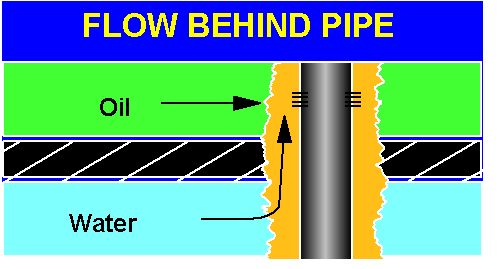Flow Behind Pipe
Problems 2 and 5 in Table 1

The difference between Problems 2 and 5 in Table 1 is simply a matter of aperture size of the flow channel behind the pipe. Problem 2, involving flow behind pipe without flow restrictions, is where the fluid flow is occurring through a large aperture flow conduit behind the pipe (greater than roughly 1/16 in.). The use of Portland cement is favored to treat Problem 2. This problem is often manifested by a total lack of primary cement behind the casing. Problem 5, involving flow behind pipe with flow restrictions, is where the flow behind pipe is occurring through a small aperture flow conduit (less than roughly 1/16 in.). The use of gel is favored to treat this problem. Problem 5 is often exemplified by micro-annuli flow behind the pipe. This problem often results from cement shrinkage during its curing during the well’s completion.
The recognition, importance, challenge, and necessity of successfully treating Problems 2 and 5 have become much more prominent recently with the advent of regulatory-required mechanical integrity (hydro) testing of petroleum well tubing and casing strings.
Problems with unrestricted flow behind pipe are usually treated with cement.27 Cement can perform extremely well for this type of application if the channel to be plugged is not too narrow (i.e., Problem 2). When narrow channels are encountered (Problem 5, such as micro-annuli between cement and the formation or the pipe), cement often cannot be placed effectively through small or constricted flow paths. Gels provide a better solution for this case, since they can flow or extrude readily through narrow constrictions.36-38 The ability of gels to withstand high pressure gradients increases with decreasing channel width.39 Therefore, gel alone cannot be expected to plug large voids behind pipe. In some cases, gelants or gels were injected first (to penetrate into narrow constrictions), and cement was injected subsequently to fill and plug larger near wellbore voids and to prevent gel from washing out from their strategic locations.40
When treating flow behind pipe problems where a substantial drawdown pressure (i.e., >100 psi) exists, gelants are often employed rather than preformed or partially formed gels. Three reasons often favor gelant injection when treating this problem type. First, flow constrictions in small flow channels behind pipe may prevent full penetration of preformed gel into the offending channels. These constrictions do not significantly impede flow and placement of gelant solutions. Second, gelant invasion into permeable matrix rock adjacent to the channel behind pipe is usually beneficial when treating this type of problem. In contrast, preformed gels will not penetrate appreciably into the permeable matrix. Third, because of relatively high near-wellbore drawdown pressures, gel in the channel probably will washout much more easily than gel formed in the permeable matrix. Methods of sizing gel treatments for these applications have been strictly empirical to date.
In certain circumstances, properly formulated gels of preformed or partially formed crosslinked organic polymer gels may be favored when treating long intervals of micro-annuli between the primary cement and the formation.
Refs. 36-38 provide field examples where gels showed superior behavior over cement when treating flow behind pipe.